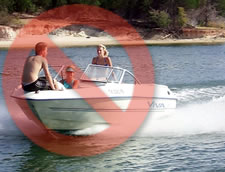Everyone can be a safer boater by following three simple suggestions:
- Take a boating safety course
- Wear your life jacket
- Don’t drink alcohol while boating
Take the time to review the following information.
Boating While Intoxicated
No one may operate a vessel on the waters of NYS while impaired or intoxicated through the consumption of either alcohol or drugs. New York law now prescribes heavy fines, imprisonment, and the suspension of operator privileges for violators.
It is important to realize that on the water, even small amounts of alcohol may greatly impair one’s ability to function in three critical areas: balance, coordination, and judgment. Compound this with such environmental stressors such as glare, heat, vibration, and engine noise, and you can become quickly fatigued, greatly slowing your reaction time. Your ability to judge speed and distance are also impaired which can limit your ability to track moving objects.
Alcohol will also decrease your coordination. Simple tasks such as climbing a ladder to the bridge, or reaching for your sunglasses on the other side of the dash may become challenging. Your ability to survive should you find yourself unexpectedly immersed in the water decreases when under the influence. Alcohol will not only make it more difficult to reach for and put on a PFD, it may also increase one’s disorientation upon entering the water, reducing your chances of rescue.
Speed
Vessel speed is generally limited to 5 mph when within 100 feet of the shore, a dock, pier, raft, float, or anchored boat. Local laws and ordinances may further regulate the speed of boats operated within specific areas; check with authorities regarding local regulations.
When no speed limit is posted, vessels must always be operated in such a fashion so as not to endanger others. A vessel must be able to stop safely within the clear space ahead. A vessel operator is always responsible for any damage caused by the vessel’s wake.
Overloading
Overloading any boat will decrease stability and reduce performance. A capacity plate placed aboard vessels less than 21 feet in length will tell you just how much weight and/or people the boat may safely carry. At no time should the capacities of the vessel be exceeded.
Overpowering
Operators should also strictly follow the manufacturer’s recommendations for engine size. A larger engine may make your boat run faster, however it may have not been designed to handle the weight or stress.
Bow Riding
Bow riding is extremely dangerous, unless the vessel has an open bow designed specifically for passengers. If the boat hits a large wake or wave, or makes a sudden, sharp turn, the person riding the bow may be thrown overboard. Captains should insist that their passengers take a seat, and stay in that seat, while the boat is underway.

Additional Information
These are links to external sites, we are not responsbile for the information provided on these sites–these links are provided as a reference.
New York State Boater’s Guide
Boat US Foundation Boater Safety Class (Online)
Rental Boat Safety
Oneida Lake Association Boating Safety Map
Stop Propeller Injuries Now
Navigation Rules
USCG “What you need to know about the markers on the water”
US Coast Guard Mobile App
For more information about boating requirements and safety, please call the New York State Office of Parks, Recreation & Historical Preservation (OPRHP) at (518) 474-0456 or visit the OPRHP boating page.